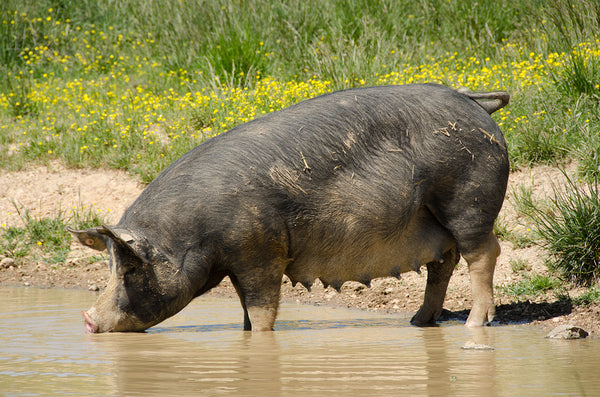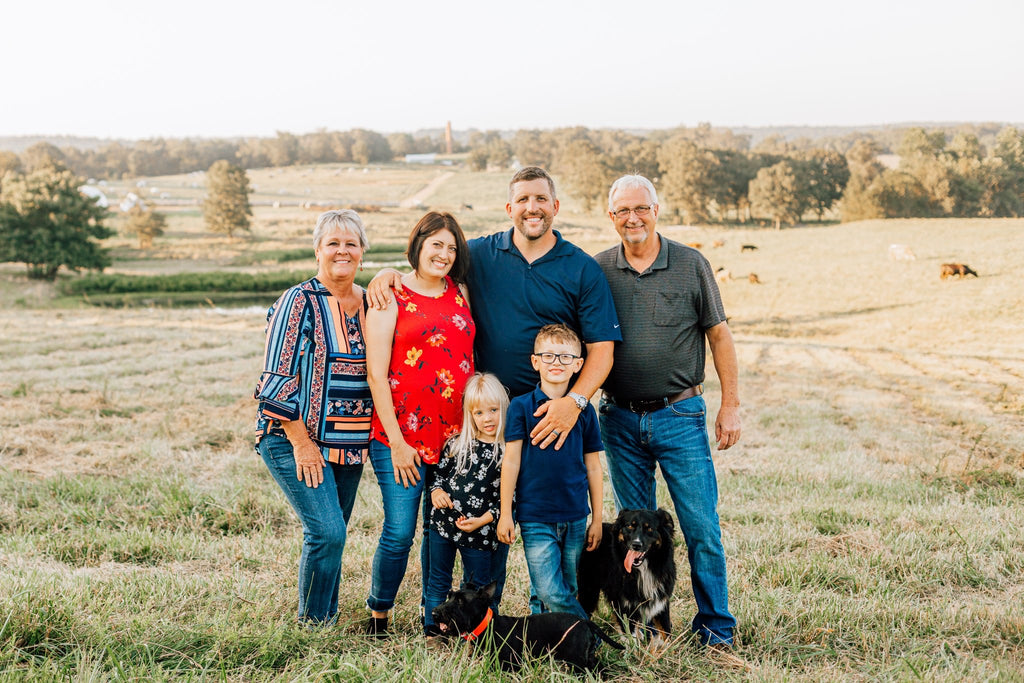
The History of the Well-Bred Pig
Something happened to the pig about 300 years ago on farms in the Berkshire region of England near London, something very special. Farmers made magic in those pens and paddocks. The story of the Berkshire is a story of breeding, breed maintenance, and breed improvement over centuries, beginning when the ancestor of today’s Berkshire was reportedly discovered by Oliver Cromwell’s army in winter quarters at Reading, the county seat in the shire of Berks. The Berkshire pig is still by far consistently the most decorated and award-winning pig for taste and flavor (followed by the Duroc). Over centuries, professional taste tests by novices and professionals alike have confirmed that meat quality on the Berkshire is unrivaled.
The basic stock of the Berkshire was refined early on with a cross of east Asian bloodlines by Lord Barrington in 1823. But since then, for the past 200 years, breeding was carried out dutifully to the letter, preserving the exact traits of the Berkshire so that the pig of the early 1800s is almost identical to the one we know today. Over the decades rumors of breeder skills grew along with the reputation of delicious Berkshire pork, throughout England, the U.S., Japan, and today to wherever pigs are loved.
Breeding is an art, it is where the pedal of livestock farming hits the metal. Good breeding is why some foods — or pork chops — taste better than others, why some meats are sweet and juicy and others dry, and why some meals are remembered years later and others forgotten within minutes! It is possible that Berkshire farmers got a head start as some believe the breed has unusually small muscle fibers and more of them, increasing their ability to bind water and therefore to produce supremely juicy and tender meat.
The most reliable method for deciding which sows and boars to keep and breed and which not to keep is based on a pig’s siblings – barrows and gilts. Good quality in one means brothers and sisters should be similar in conformation. One can also determine meat quality once a pig reaches market weight but at this point in the process many pigs are already on the ground and breed improvement is more difficult.
Live evaluation, or the eye test, has been the most reliable method of breeders until the invention of machines. For generations and across all livestock, farmers judge the conformation of an animal including how it is built from the feet, legs, muscle, to their gait. Each piglet identifies with its own nipple when nursing, so it’s important to select for six nipples on each side of the sow and the boar. Six on each side ensures each piglet in a litter of twelve has a food source. The length of the animal is also important — the Berkshire is known to be a longer breed thus producing more chops and bacon and cuts that are a perfect size for the end user.
The eye test also determines if certain pigs can survive better than others and if they can naturally mate easily. Smaller producers like Newman Farm, who are loyal to the preservation culture of heritage breeds, take the time to pay attention to these details ensuring consistently great meat. For these breeders, a well-rounded and balanced animal is their goal and they breed for quality not quantity.
Corporations also make breeding choices, but for them desired traits include fast growth and feed conversion. Fat is often bred out even though fat is where the flavor is. By crossing Berkshires with other breeds these corporate farms get what they are looking for, but the flavor changes.

For these reasons we partnered with purebred smaller scale Berkshire farmers when we first started Heritage Foods in 2004. And it is why we eventually partnered with Newman Farm in the Ozarks to raise such a large percentage of our supply. We first received a letter from Mark Newman in the mail telling us about his Berkshire herd. It would turn into a relationship that lasted over 20 years. David Newman is Mark and Rita’s son and is widely considered the foremost breed expert on Berkshire breeding in the U.S. and maybe the world. He now runs the farm.
The Newman Family originally chose the Berkshire because of its rich tradition in England where for centuries it was prized as the best eating pig — for years the Royal Family kept a large Berkshire herd at Windsor Castle. The Newmans loved the purity of the Berkshire and the story of preservation it represented. And they loved the taste of its meat!

For David Newman, two of the most important traits for breeding are mothering ability and meat quality, and the Berkshire is known for both. Maternal traits include docility, decent litter size, and the ability to produce good milk — his goal is 8-10 piglets per litter when the sow farrows twice a year. Meat quality is judged by tenderness, marbling, and color. David and other leaders in the industry are constantly testing their Berkshires for meat quality. Because David is also a meat scientist, he searches for facts and uses machines.
The Berkshire consistently scores higher than other breeds for color, marbling, and tenderness. The color is darker — 3 or better on their scale — and marbling ratings clock in at 3% or better. Tenderness is measured with a machine (called Warner/Bratzler Shear Force Test) for the threshold in pounds of force — when the meat is tough to sheer it gets a low score. If all is good, the pig gets an ear notch for a permanent method of identification.
According to the best available records, the first Berkshires were brought to the United States in 1823. Famous boars were touted at fairs and in show rings around the country. Farmers paid a good premium to bring descendants of these great pigs onto their farms to start Berkshire herds or to cross them with pigs they already had. Berkshires almost guaranteed better pork quality and their black coat made them resistant to sunburn and their fat made them hardy, meaning they were great survivors.

In 1875, a group of Berkshire breeders and importers met in Springfield, Illinois, to establish a way of keeping the Berkshire breed pure and the American Berkshire Association was founded, officially codifying the traits of the Berkshire forevermore. The first pig registered was a boar named Ace of Spades, reportedly bred by Queen Victoria. Only directly imported stock from established English herds, or hogs tracing directly back to such imported animals, would be accepted as true Berkshires.
Berkshires of today are black pigs with white spots. The pig has a short, dished face with ears pointed slightly forward. Most have six white spots — on the tip of the feet, nose, and tail — but not all. The chops are perfectly sized and no one cut is unusual in any way — to many it is the perfect pig.
The Berkshire pig is not on the brink of extinction but pure Berks are still very rare. As David says, “no one could scale the Berkshire if you wanted to.” Back in England, especially in the 1950s and 1960s, traditional breeds like the Berkshire were cast aside in favor of the bigger, leaner white breeds from mainland Europe. The Berkshire fell into the hands of enthusiasts, who continued to raise them with the support of organizations like the British Pig Association and the Rare Breeds Survival Trust.
In the U.S. it was thought that Japan, where Berkshires are known as Kurobuta, would help preserve the pure breed. The pigs were first exported to Japan in the 1860s and a major push took place in the 1990s. But since then demand in Japan has dwindled. Thankfully since then, chefs in professional kitchens have started to demand the Berkshire breed and its population counts are rising.

